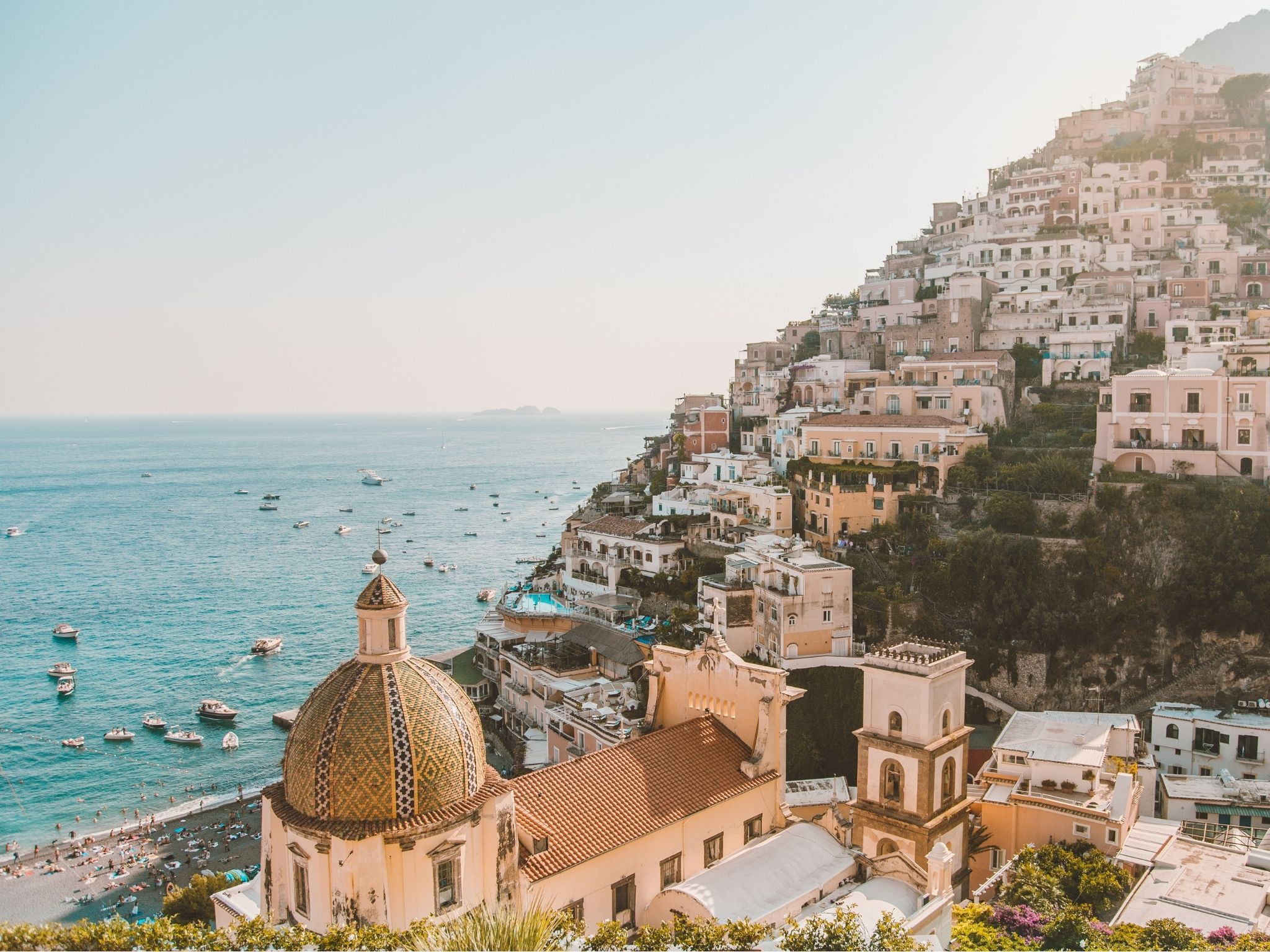Looking for travel tips to the Amalfi Coast to better prepare for your trip?
You’ve come to the right place!
This article covers all the essential information you need to know before visiting the Amalfi Coast, especially if you are traveling with us.
Be prepared for your trip with our Amalfi travel tips and our packing list here, and get ready for a fabulous trip!
Below is a little history lesson on Italy to better understand everything that has made the country what it is today. To skip right to our travel tips, click here!
Brief history of Italy
The history of modern Italy starts with the Roman Republic, founded in Rome in the 8th century BC and evolving into an empire in the 6th century BC. It was this empire which dominated most of Italy as well as southern Europe and North Africa for well over a millennia.
The Roman Empire thrived and expanded across the Mediterranean until the 5th century AD, with the Fall of the Western Roman Empire in 476, when it disintegrated into several separate states.
Some of these such as the Venetian and Genovese States, continued to rise through trade, shipping and commerce, while other parts of Italy, especially the south, fell under the influence of other crowns.
Even during the 16th century Renaissance period, which originated in Florence and spread across Europe, Italy was still fragmented and made up of several states and republics.
During the 18th century, what we today know as Italy was heavily divided and subject to the results of the many wars of succession in Europe, with the northern territories belonging to the Austrian Empire and the southern part unified into the Spanish Crown.
Wars were so common that the various regions of Italy changed hands multiple times.
It was when Napoleon conquered most of the country during the French Revolution that the country was first called the Kingdom of Italy and mostly unified.
But it was not until later on, in 1861, after the war of independence led by national hero Garibaldi, that the whole of Italy was finally unified under one country.
The country did not become what we know it as today until WWII when fascist Mussolini, a WWI veteran, rose to power and joined Nazi Germany.
After the war, the civil unrest that ensued, and then the death of Mussolini, Italy reinstated democracy and developed financially enough to become one of the founding members of the European Union and NATO.
Quick facts about Italy and Amalfi Coast
Italy is one of the most beloved countries in Europe. The birthplace of Renaissance, home of great food and incredibly diverse and beautiful landscapes.
Familiarize yourself with the country and with the Amalfi Coast to better prepare for your trip.
Fun and interesting facts about Italy
To understand Amalfi, one must first have an insight into Italy through some of its fun and interesting facts.
- In Italy, like in Spain, many businesses will close at lunch time for a break. They usually close the store, go home, cook lunch and maybe sneak in a quick nap. That means that shopping, especially in smaller towns, needs to wait until shops reopen again at 4pm. It is also common for shops to be closed on Sundays.
- Did you know there are two countries completely landlocked by Italy? That’s right, The Vatican, which you probably knew about, and San Marino on the eastern coast.
- Italy has the most UNESCO world heritage sites in the world closely followed by Spain and China. Entire towns such as Siena or Pienza are listed, as are landscapes and other historic sites. The Colosseum in Rome is also listed and is the largest amphitheater ever built, with a capacity of 50,000 to 80,000 spectators.
- Shakespeare loved Italy and in fact 13 of his plays are set there, although we can’t be sure he ever went.
- The Vatican City, which is located within Rome, is the smallest country in the world in terms of land area and population.
- Italy is home to many active volcanoes, most notably Mount Etna and Stromboli, both of which are pretty active, and Mount Vesuvius which famously preserved Pompeii under layers of lava and ash.
- In normal times, Italy receives more than 60 million visitors a year making it the 5th most visited country in the world.
- Italians are born investors and we can thank them for having come up with corrective eye glasses, the first bank, ice cream cones, the jacuzzi, batteries and thermometers.
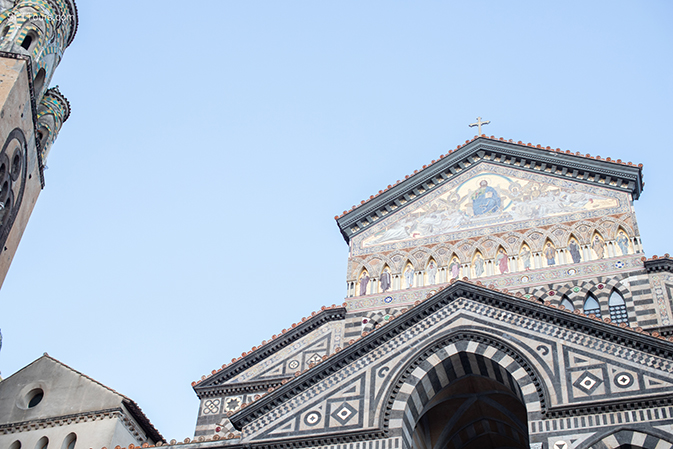
- Italy is one of the top-10 largest economies in the world. Member of the G7, G20 and founding member of NATO and the European Union.
- More than half of Italian men live with their mothers and this has been considered by the Church as one of the biggest risks to marriage in Italy, perhaps also the reason why the country has the lowest birthrate in Europe.
- Italians don’t fear number 13 but number 17 which in Roman numerals is XVII and can be rearranged to spell I have lived, or death.
- Did you know that the regular Italian alphabet does not contain letters J, K, W, X or Y?
- There are more than 140 kinds of pasta and each shape is not just chosen for fun but because it best matches the sauce or condiment. Therefore, don’t change the type of pasta when ordering something off the menu, there is a reason why the two are paired together. Pasta is a very old dish eaten since the 14th century at least.
- Italy has more than 3,000 museums, including the Uffizi Gallery in Florence, which houses some of the world’s most famous works of art.
Fun and interesting facts about the Amalfi Coast

- Amalfi was the capital of the republic of the same name for four centuries from the 7th to the 11th, when it fell to the Normans like Sicily. This seafaring culture was constantly under the attack of Turkish pirates and so you will find many watch towers along the coast, look out for them.
- Two very quintessentially Italian items come from the Amalfi Coast: limoncello and pizza.
- There are several UNESCO listed villages in the area including Positano, Ravello and Amalfi . Besides the villages, the landscapes of the Amalfi Coast are actually listed too, and no doubt they are stunning.
- According to legend, the city of Positano was created by the Greek God of the Sea, Poseidon, to show is love for the Goddess of Rest, Pasithea. It sure feels supernatural.
- And talking of Mount Vesuvius, it is not extinct, just dormant, and it could explode anything and threaten the lives of the millions of people that live in its periphery. Hopefully, it does not do so while we are there!
- Many Dolce & Gabbana ads (Light Blue) and clothing designs are inspired by the Amalfi Coast, especially the lemons, that feature on many of its designs.
Amalfi travel tips

In this section we want to share general Amalfi Coast travel tips to help you plan your trip.
When to visit
The Amalfi Coast is truly a vacation destination in Italy frequented by both locals and foreigners in th summer months. In the winter, it is cold and mostly closed while in the summertime, the crowds fill streets, beaches, shops and roads.
The busiest months of July and August are to be avoided at all costs. Not only does it get hot but also the crowds and popularity means everything is full and prices are running at a premium that could be twice or thrice as expensive as in the quieter months.
We like to visit in June and September for balmy weather and emptier places.
Passport and visa requirements for Italy
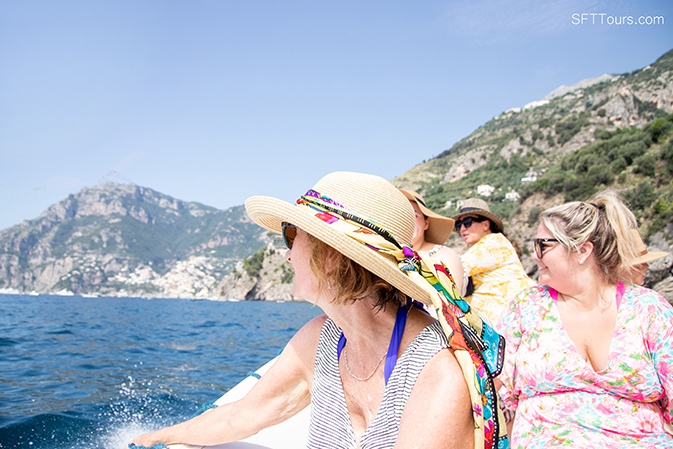
Get your passport and travel documents in check before your trip to avoid any delays at the border.
- Visa. Italy is part of the Schengen zone so you should check if you need a visa in advance with the official resource here. A Schengen visa will allow you to travel for 90 days within a 180 day period in the Schengen zone but typically, your visa application needs to be for the first country you will be landing at.
While the general process is similar for all countries within the zone, the requirements do change and can take weeks to process so allow enough time for this. If you are unsure about the visa application process you can use a service such as iVisa to do it for you.
- Validity. We strongly recommend that you make sure your passport is valid for at least 6 months after departure and has 2 empty pages.
Health and safety
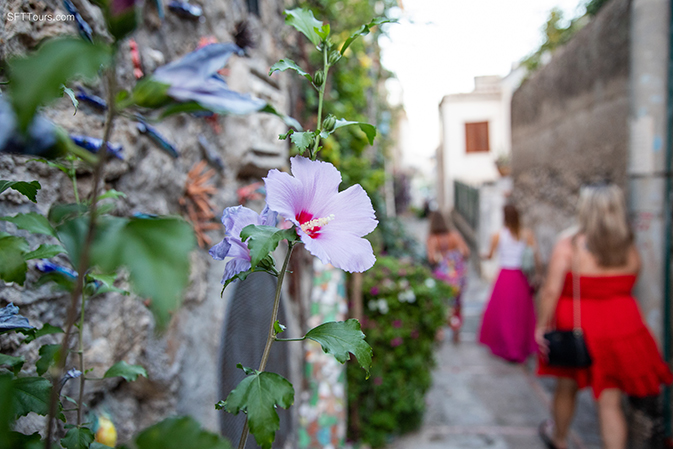
Italy’s universal healthcare system is great and most towns will have a local clinic for small emergencies while bigger hospitals are available in larger cities.
- Bring all the medication you’ll need. While during your trip to Tuscany you will never be too far from an urban center, a doctor, a hospital and a pharmacy, it is strongly recommended to bring any prescription medication you may need and enough of it to last you the entire trip.
Your specific medication may not exist in Italy, or it may require a prescription you need to see a doctor for, save time and hassle by bringing everything you may need with you. Review what you should bring in your first aid kit here.
IMPORTANT: Make sure any prescription medication comes in its original pharmacy packaging, and with the corresponding doctor note and prescription to avoid issues at the border. It is your responsibility to check that whatever medication you bring can indeed be taken into Italy. What may be legal in your country, or even sold over the counter, could be a controlled substance elsewhere. Check the legal requirements to bring controlled substances into Italy here and take note of the documentation needed.
- Get that coverage. We never leave the house without purchasing extensive medical and travel insurance coverage and this is why we make it mandatory to join our tours.
While in Italy you will be helped in case of a medical emergency whether you can afford it or not thanks to a universal healthcare system, you should make sure that you have adequate medical insurance to cover any unforeseen medical expenses.
Unexpected accidents do happen, and if you needed to be evacuated back home with an injury, the medical bill could bankrupt you. It is also unfair to expect Italians to pay for your medical treatment with their taxes.
The best travel insurance will differ for each traveler, depending on the nature, style, and length of your trip, so we recommend using an aggregator and comparison tool such as Travel Insurance Masters to find the right one for you depending on what coverage you want, age, location, trip, etc.
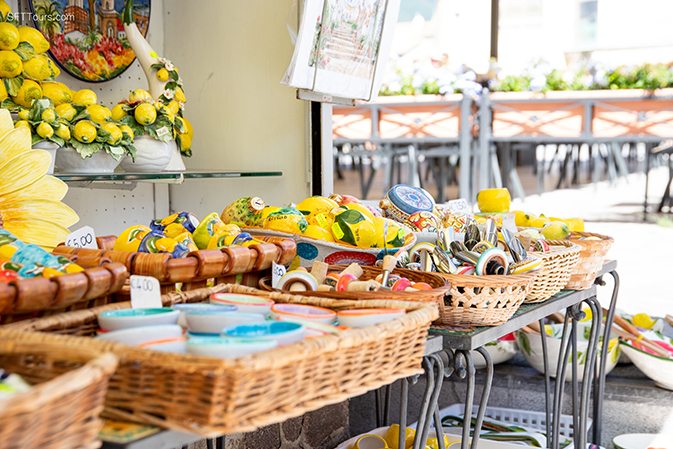
- Tap water. Generally, tap water should be safe for drinking but you should always double check, especially in farm houses. Bring a water bottle with you to top up at the public fountains. Some towns have sparkling water fountains for a nominal fee.
- Staying safe. Italy is a generally very safe country to travel to. However, in popular tourist areas or attractions, pickpockets operate and have become quite smart and elaborate in their scams and theft operations.
Always keep your valuables safe and your bag in the front and zipped. Slash and theft proof cross-body bags are a great idea, here are our recommended bags. In crowded areas, keep your arm on your bag’s zipper for extra protection.
If something is to happen to you, you will most likely not even notice, but look out for situations in which anyone is trying to distract you by trying to sell you something, talking to you or drawing your attention to anything while a partner steals your wallet or phone. And don’t fall for the photo ops with gladiators and other characters, unless you are fine with giving them a tip. Read our full article on safety tips here.
- Passport copies. All hotels are required by law to take a picture of your passport so don’t be alarmed if they do.
Getting to / from and around the Amalfi Coast
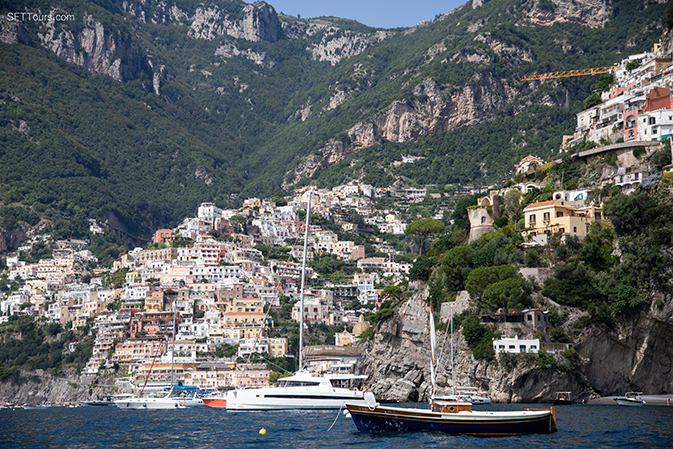
Getting around the area is one of the most important and frequently asked questions, hence why I added a separate section just for this in the case of Amalfi Coast.
- Getting to and around Italy. There are many major airports in Italy to land at (Rome, Milan, Naples and Florence for example) but a great way to travel across the country is by taking the high-speed trains which are clean, on time, affordable and offer free WiFi. We prefer to take them to go from our trip destinations, from Amalfi to Venice and Tuscany.
You can find the timetable and get tickets on TrenItalia in advance. Remember to always validate your ticket on the machines before boarding the train to avoid a fine. Having a ticket is not enough (unless they are purchased online and for a specific time in which case you don’t have to validate them).
Uber or other international hailing apps do not exist in Italy. The closest to that is MyTaxi. Check out more useful travel apps to get around here.
- The roads. The roads in the Amalfi Coast are windy, mostly one lane and narrow, that is, they are not for the faint of heart. If you get car sick, sit at the front and bring motion sickness medication. If you don’t normally get car sick, also bring them just in case.
- Car insurance. If you rent a car, make sure to get the full insurance coverage, scratches and bumps are very common and people drive worse and worse the more you get away from Naples.
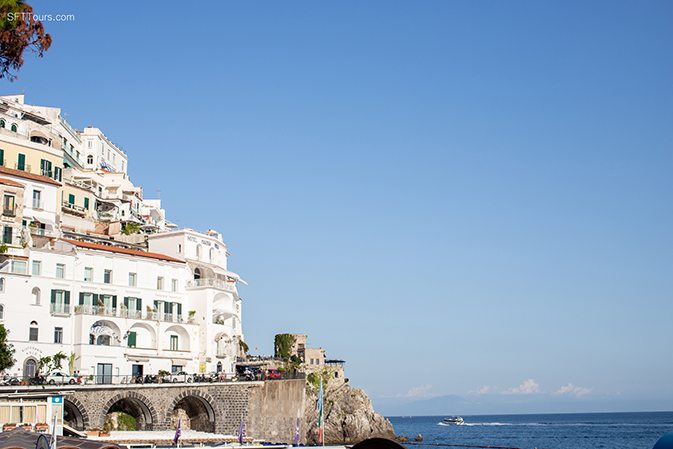
- Buses around the Amalfi Coast. If you don’t drive, it is possible to take the SITA buses between the cities in the Amalfi Coast. Timetable for the buses is here and they sell 24h bus passes that let you take as many rides as you like, buy them at the tabbacheria, newspaper stands, and bars and cafés in all the towns along the Amalfi Coast that have the SITA sign.
If the bus is full, it may not stop and queues are common at the main stops in Amalfi and Sorrento. If all seats are taken, you will have to stand, so make sure to find something to grab. As you probably guessed, taking the bus with lots of luggage can be a struggle…
- Ferries. Ferries are a more convenient and fashionable way to get between the main towns in the Amalfi Coast. You should book your ferry ticket in advance here, or on a ferry booking service like Ferryhopper or Ferryscanner.
- Trains in Amalfi. Alternatively, trains are your best bet. You can connect from Naples to Pompeii and Sorrento easily via the Circumvesuviana train.
- The walking. As you probably guessed by the location and the geography of the area, it isn’t just the cars that have to work extra hard, people also need to climb a myriad of stairs and steps throughout the region just to get around, always walking up and down the hillside. Towns are perched on cliff sides, and the hotels and restaurants are too.
You need to be fit and wear the right shoes to not just walk the stairs but also the cobblestone and uneven rocky paths and streets. A great way to work those incredible Italian meals! See all of our shoe recommendations in our Amalfi packing list here.
Essentials
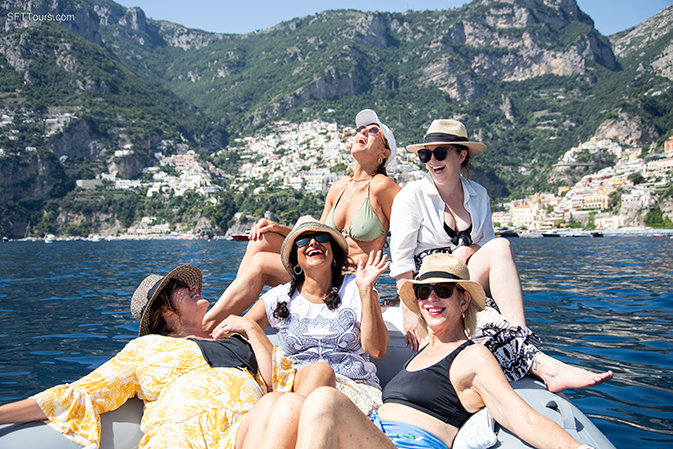
Italy is a very regional country with huge differences from province to province in terms of food, gastronomy and traditions. This section includes both tips for travel in Italy as well as tips for traveling in the Amalfi Coast.
- Public holidays. Italy has several public holidays and during these days, most businesses will be closed, this means attractions such as museums may not be open.
Plan around the most important ones such as Christmas Day (25th December), Boxing Day (26th December), New Year’s Day (1st January), Epiphany (6th January) and Easter Friday and Monday (changing every year), St. Mary (15th August) and All Saints Day (1st November).
- Air conditioning. It can be really hot in the summer months in Italy yet many places don’t have AC. All the hotels and villas we stay at have air conditioning units but it is always worth checking in advance.
- Have an ID with you. It is a legal requirement in Italy to carry an ID with you at all times, though we recommend leaving the passport at home while carrying a local ID or driving license with you instead.
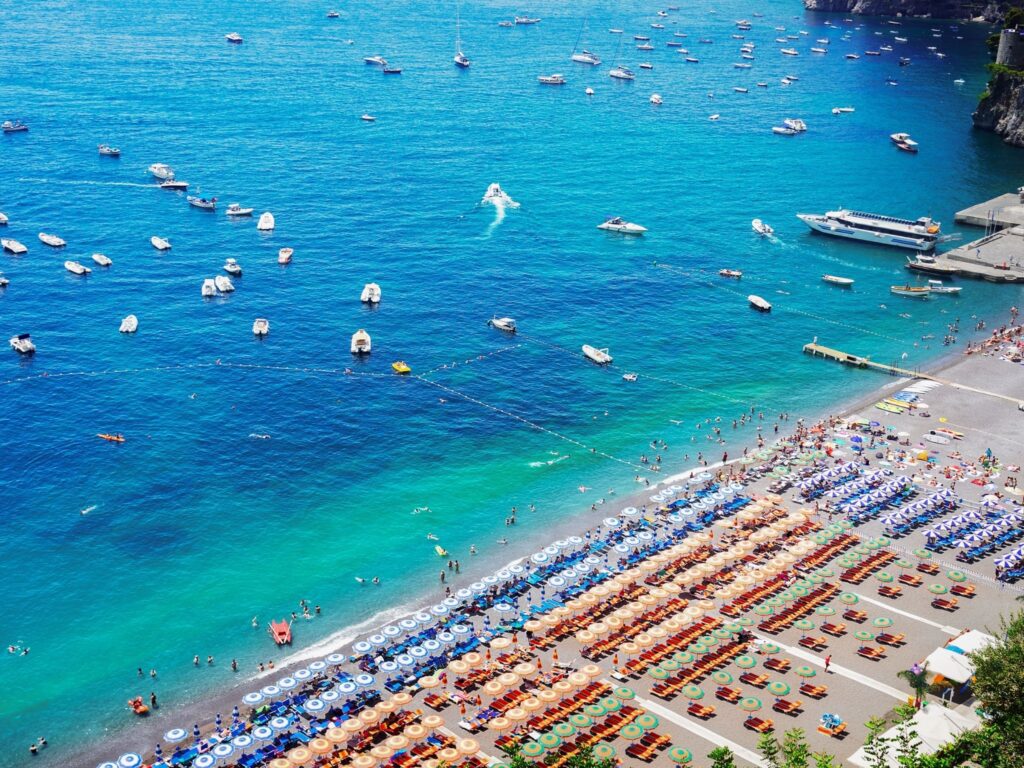
- Beach chairs. Across the Amalfi Coast you will find lines of perfectly laid beach chairs and loungers, they are not cheap (20EUR a day or more is common) but they save you from the uncomfortable pebble stone beaches (the beaches in Amalfi are not powdery but made of pebbles) and the crowds as you will have a bit of a space for yourself. They also often come with facilities such as access to public toilets.
- Staying connected. Public free WiFi hotspots are not really a thing so explore roaming options with your home mobile provider or get a local SIM card at the airport or in town at tabaccheria stores to stay connected, or an eSIM online like AloSIM or Airalo before your trip (you need internet to download the eSIM card).
Make sure your phone is unlocked so that a foreign SIM card will work, and get the store staff to help you set up the new SIM card before leaving the shop so they can help you with any settings that need changing.
- Public toilets. Many of the towns in Tuscany and across Italy have public bathrooms that are clean and accessible. They usually cost 0.5 EUR which can only be paid in coins and are marked with signs. Some of the have change machines nearby where you can break down your EUR.
Additionally, all bars and restaurants are required to let you use their facilities for free. We recommend a small purchase out of appreciation.
- Dual voltage. Many small and older appliances that you may use back home may not work in Italy (or other European countries). This is because the voltage is not the same. If you have an old appliance, consider leaving it home, most hotels have hair dryers. The photo ops in the Amalfi are plenty, so plan to have a power bank with you if you need to charge electronics on the go.
Outlets are usually 2 prong and round (as is in all of Europe), so bring an adaptor if you need it.
- The beaches. As mentioned in the previous point, the beaches in the Amalfi Coast are rocky and made of pebbles not sand, so they are uncomfortable to walk on. Bring reef shoes to avoid cuts, and check out our packing list here to make sure you have everything you need for your trip.
Money and currency
In Italy, only Euros are accepted and no other currency. Bring both cash and cards because while cards are widely accepted, they may not be everywhere or for smaller purchases.
Minimum amounts may be required to pay by card. If you try to pay for a gelato with a 50 Euro note, the staff will not be happy. Tips are almost always given in cash.
Local culture and customs
Italians are affectionate, passionate and loud. These are not stereotypes but rather cultural traits that will help you understand culture better.
- Loud talk is not an argument. Two people yelling in the street at each other may not be having an argument but rather talking emphatically about their day.
- Dress appropriately. Even when the weather is hot, shoulders and knees should be covered inside churches and religious buildings so a shawl or scarf can come in handy. And remember that you will be walking on lots of cobblestone streets and that good walking shoes are a must. Really flat sandals with no support may become quite uncomfortable after a while, closed shoes that are non-slip are probably best. Click here to read our Amalfi packing list.
- Hand gestures. A bit like Spanish and some Latin American cultures, Italian culture uses face expressions and hand gestures to express an idea. When talking to an Italian don’t be surprised if they use their hands and gesture a lot.
Tipping
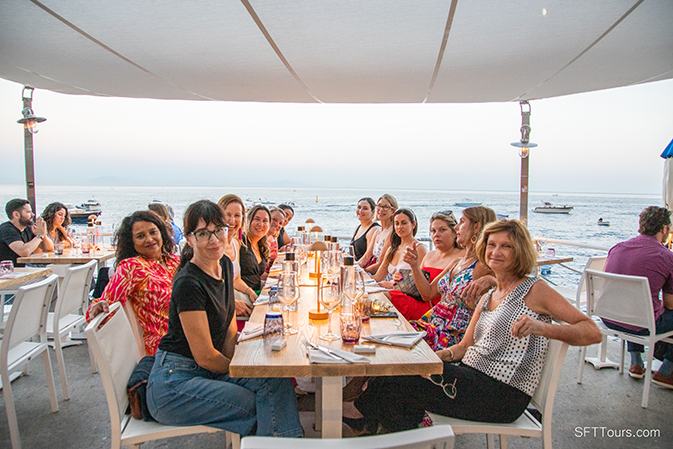
Tipping in Italy is more common than in Spain or Iceland but far less than in the US, and it should be a sign of appreciation for great service not a standard action.
You should generally tip at food establishments and not doing so would make the staff think they did a bad job. However, if the service was not good, you should not tip.
As tipping is generally done in cash, mostly in coins, it’s important to carry enough 50 cent, 1 and 2 EUR coins with you. You should leave the tip with the bill or tell the staff to keep the change (e.g. if you give a 50 EUR note for a 47 EUR bill). At a bar, you would leave it on the bar. Credit card machines don’t usually have a way to add a tip.
- At a restaurant: Round up to the nearest EUR (e.g. if the bill is 22 EUR give 25 EUR) or 10% at finer restaurants. You can tell the waiter to keep the change or leave the change on the table.
- At a bar: Leave a coin (e.g. if the bill is 1,5 EUR leave the smallest coin you got as change).
- Light meal / Aperitivo: 1-2 EUR per person.
- Guides: You may tip 5 EUR per person for a full day tour.
- Hotel staff who helped you with your luggage: 1 EUR per bag.
- Housekeeping: Not common.
- Free tours: Whatever you feel is fair for the tour. You can also see the price of regular tours for a benchmark.
You should not tip if the bill mentions “Servizio”, this means the tip has already been added. This rarely happens and you are only going to find it in high end restaurants.
If you’re still confused on how tipping works, there are travel apps like GlobeTips that can help you calculate how much you should tip in each destination.
Basic Italian words
In tourist places in Italy, you will always find someone who can speak at least basic English, and menus in popular towns and cities will be available in English, though if a restaurant offers the menu outside and in English with pictures, you know who eats there.
The Italian language was formed in Tuscany in the Middle Ages thanks to the work of writers such as Dante Aligheri (from the Divine Comedy), and while Italy has lots of regional dialects, all Italians speak Italian.
Learn some local phrases with language apps, which will help you out and show locals you made an effort. Below are the most useful ones.
- “Ciao” is hello and goodbye but is rather informal. When you enter a shop, you could say ciao but it would be more polite to say “buon giorno” for good day or “buona sera” for good evening.
- “Arrivederci” is goodbye.
- “A presto” for see you soon.
- “Per favore” is please.
- “Grazie” is thank you.
- “Prego” is a useful word used to mean “you are welcome”, or as a response when someone says thank you.
- “Non capisco” means I don’t understand.
- “Scuzi” is sorry.
- “Quanto costa” to ask for the price of something.
- “Acqua liscia / gassata” for still or sparkling water.
- “Come stai?” is how are you.
- Italians say “Salute” when clicking glasses.
- “Il conto” when asking for the bill.
And remember, if you see Italians shouting it does not mean they are having an argument, they could well be having a passionate conversation or talking about football.
Local cuisine
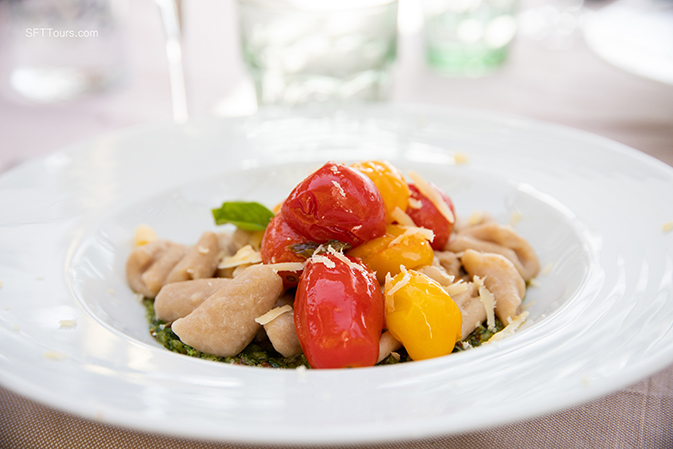
Food and gastronomy are essential to any trip to Italy, so let us tell you more about eating habits and customs, as well as the best dishes to try in Tuscany.
Eating in Italy – What to expect
Italians eat later than other countries but not as late as Spaniards. Lunch is usually at 1pm and dinner from 7:30pm.
There is a huge coffee culture in Italy, but not in the way that for example Australians may interpret that.
Italians call what you may think of as a cafe a “bar”. Bars in Italy are places that are open during the day and serves snacks, maybe even a light meal and drinks such as coffee, not a place with music, alcohol and party, though alcohol is served.
Worth noting that “bars” are places for a quick break, that is, you don’t go there to lounge and sit down but to enjoy a drink or quick snack often at the bar.
If you sit down to enjoy your time, especially if you choose a terrace or outdoor space, expect a table service charge to be added which can often be more than the price of an espresso.
Besides the table service charge, there is also a “coperto” or cover charge which is usually a fee for cutlery and bread charged per person.
This is a historical charge also often found in Spain, that is hard to understand today other than for the bread that you get. You can’t get away from paying it as it is a default charge, but it is usually mentioned on the menu.
In terms of picking where to eat in the Amalfi Coast, best to avoid places that look like they were designed for tourists (picture menus, English translations, waiters waving you in in your native language, etc.).
It is also highly recommended to avoid sitting at the main square if you are on a budget. Trattorias and osterias are good local options to enjoy an authentic meal by yourself.
We love to people watch and that is what makes Italian squares amazing, but you should expect the show to come at the price of a high coperto and table service charge plus most likely inflated prices. Be aware to avoid disappointment.
Best foods to try in the Amalfi Coast
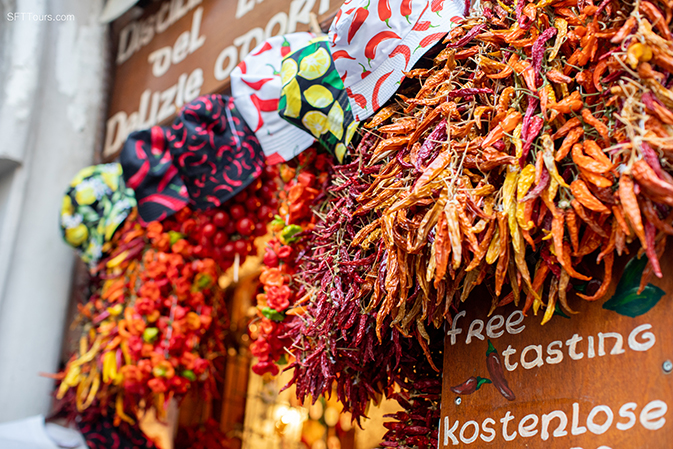
When talking about food in Italy, it is also worth remembering that a lot of the dishes you may be used to seeing in Italian menus abroad are not in fact Italian.
Dishes like pasta alfredo, spaghetti bolognese, pizza with pineapple or pizza pepperoni are an American invention and if it’s on a menu in Italy you know who the restaurant is for.
Oh, and “latte” is “milk”, so if you want a coffee with milk be sure to order a cappuccino or a latte macchiato; just latte will get you a glass of milk.
The vast regional wealth of Italian cuisine means that some dishes are only found in one place.
For example, pizza and pasta are everywhere but the toppings or sauce changes dramatically, and famous foods such as cannoli are from Sicily and not commonly found anywhere else.
Pro tip: Italians don’t eat pasta with a spoon, they simply twirl the spaghetti around the fork.
Here are some of the best dishes to try in the Amalfi Coast, though beware that many may not be in season when you visit:
- Caprese salad: The omnipresent and deliciously simple salad with mozzarella and tomato takes it name from the island of Capri and the tomatoes it should be made with grow on the same island. Mozzarella buffala, the high quality mozzarella cheese made from the milk of the buffalo, also comes from Campania, specifically Salerno and Caserta, so the entire dish is local to the Amalfi Coast.
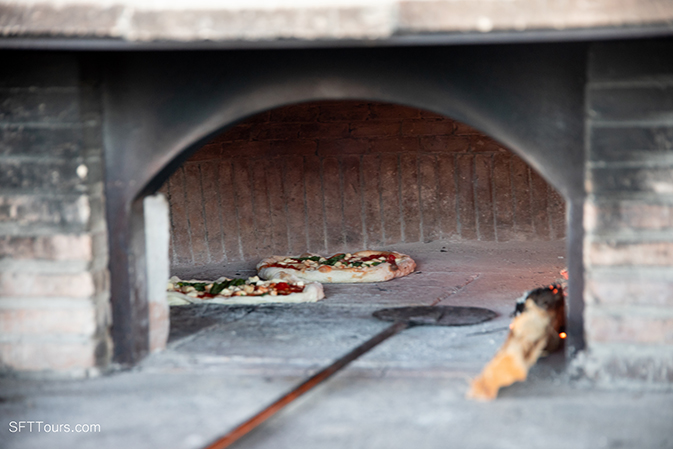
- Pizza: Invented in Naples, the Napolitana Pizza is just amazing, crusty on the outside and melting inside, if you come to the Amalfi Coast, you can’t miss some great pizzas along the way.
- Seafood, seafood, seafood: The whole area is sea-facing and so there is plenty of fresh seafood to enjoy.
- Spaghetti alle vongole: spaghetti with clams are one of the most commonplace dish in the area.
- Salumi: Like in Spain, Italians eat a lot of cured meats of all kinds and this is the name used to refer to all.
- Gelato: Ice cream in Italy is creamy and soft and served everywhere in the summer but not all gelato stores are the same, we can only recommend you try a few and learn the difference for yourself.
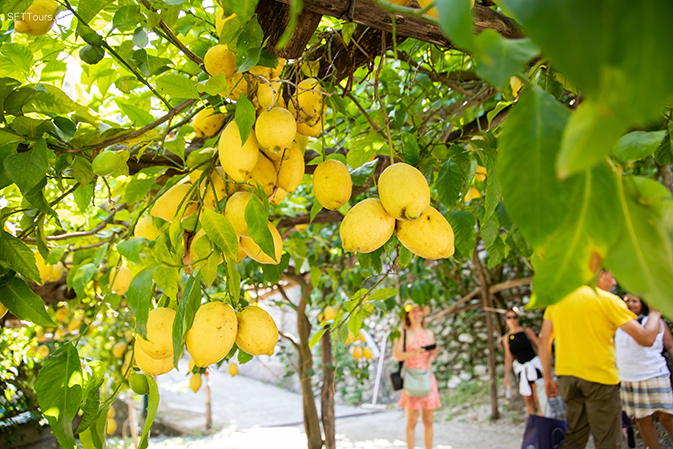
- Lemon-anything: As mentioned, lemons are life in the Amalfi Coast so be sure to try anything that has lemon in it, from candies, to sorbet, to lemon pie.
- Seafood risotto: Seafood lovers will be happiest in the Amalfi Coast and this rice dish with fresh seafood is a must try.
- Tuna and anchovies: And on the topic of seafood, tuna and anchovies are a local delicacy in the Amalfi Coast, and the tuna is high enough grade to make sushi, although of course that is not an Italian dish.
Best drinks from the Amalfi Coast
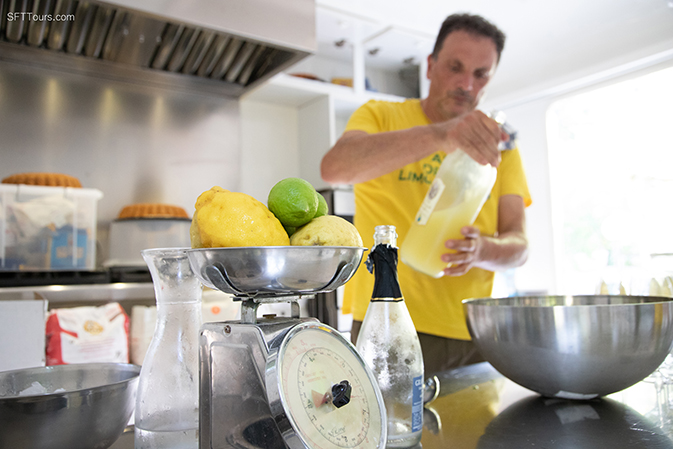
Across Italy, you will always find Vino della casa (house wine). Wine is pervasive and fantastic in Italy and in casual eateries, it is common to offer house wine with meals. This is bought wholesale and served in a jar (250ml, half a litre or a litre) for a very modest price. If it’s not on the menu, ask about it.
Aperitivo is enjoyed before dinner and consists of a drink (does not have to be alcoholic) and some snacks which could include bruschetta, cheese, cold cuts, olives, tomato, etc. along with great conversation.
If you like coffee, you’re in for a treat in Italy. Just know that Italians drink espresso-based coffee, 14 million a year, and that the amount of coffee is small and intense.
Large cups of watery coffee are just not a thing in Italy. When you order a coffee, it will be an espresso by default, you don’t need to specify (un caffè -> an espresso).
The most common drink from the Amalfi Coast is limoncello, made from the very unique and specific lemons that grow in the area. We will be visiting a lemon farm during our trip and will taste the fabulous limoncello, an easy liquor anyone can make at home.
Wines from Amalfi
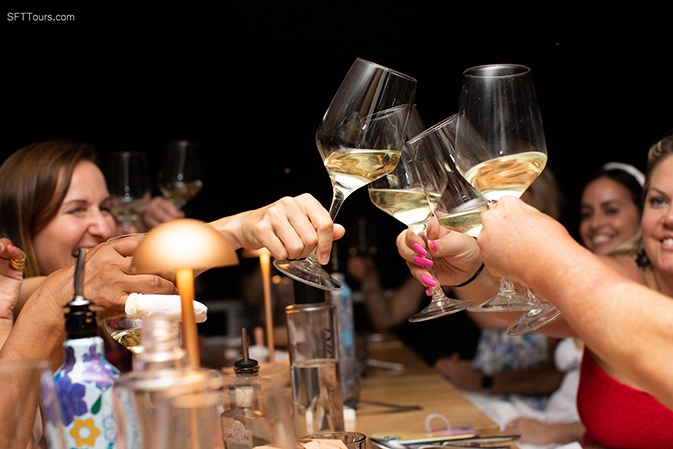
The Amalfi Coast is part of the appellation of origin wine region DOC Costa d’Amalfi and is not famous for wine as Tuscany is, but it is famous for a very special type of terraced landscape with vines growing on the steep hills.
Wineries and vineyards are perched on cliff sides and sometimes hidden inside grottos and the wines are very interesting because of this rocky volcanic soil. After all, Mount Vesuvius is just next door.
Don’t expect to find a merlot or cabernet sauvignon here, the varieties grown are the local ones rarely found elsewhere which makes the wines extra rare and unique.
Books about or set in the Amalfi Coast
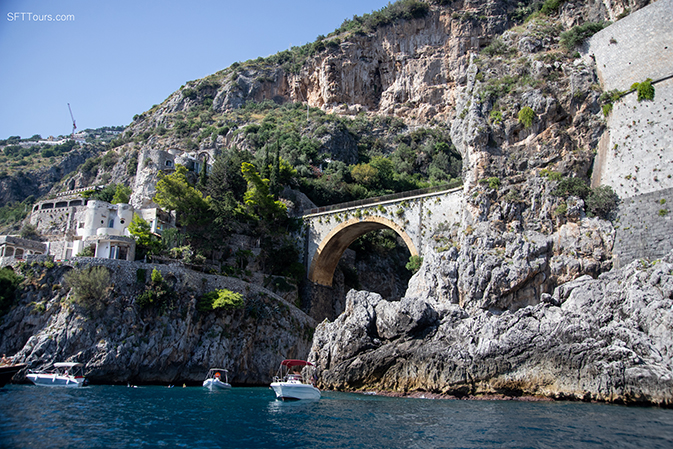
The Amalfi Coast’s stardom is partly thanks to the many books and movies set in the region which captivated audiences across the world. To better understand the region, have a look at a few of the below books:
- The Talented Mr. Ripley by Patricia Highsmith: Set in an imaginary town designed after Positano, this novel follows conman Mr. Ripley and will transport you to the beautiful town.
- The house in Amalfi by Elizabeth Adler: The local Eat, pray, love version of the Amalfi Coast with the main character escaping to Amalfi.
- Pompeii, a Novel by Robert Harris: This story set in Pompeii before it was destroyed by the volcanic eruption gives insight into what life was like.
- The volcano lover, a romance by Susan Sontag: The famous author of one of the most repeated travel quotes of all times (“I haven’t been everywhere but it’s on my list”) has a novel set in 18th century Naples that follows the love life of the Ambassador to the King of Naples.
- The night villa by Carol Goodman: Set in modern day Naples and Pompeii, this mystery novel focuses on the slave girl who lived in the Night villa when the Vesuvius explosion covered Pompeii in ashes.
- Gelato sisterhood on the Amalfi Shore by Chantal Kelly: Take a fun and interesting journey through the entire coast by the hand of its author’s humor and anecdotes and the group of women she shows around.
Movies and shows about or set in the Amalfi Coast
The Amalfi Coast has always been the playground of the rich and famous, focus on famous, and many directors and actors have homes or liked to vacation here, from Greta Garbo to Fellini or Sofia Loren.
If you want to immerse yourself in the vibe of the region, here are some of the movies you should watch.
- The Emperor of Capri, by Luigi Comencini: This rom-com features one of the most famous southern Italy actors as the waiter confused for a prince by a gold-digger. Funny and a great way to see Capri on film.
- The talented Mr. Ripley, by Anthony Minghella: Featuring Matt Damon, this famous Hollywood movie follows conman Mr. Ripley and will show you wonderful views of the region.
- What?, by Roman Polanski: Movie produced by Carlo Ponti and featuring Marcello Mastroianni as a retired pimp. The plot is unique but the setting in the Amalfi Coast is breathtaking.
- L’Amore, by Roberto Rossellini: Is entirely set in the Amalfi Coast and is part of a film anthology wrote by Rossellini and Fellini.
- Beat the Devil, by John Huston: Star-studded movie set in Ravello with Humphrey Bogart and the beautiful backdrop of the Amalfi Coast.
- Wonder Woman, by Patty Jenkins: The 2017 version of the movie was filmed in Villa Cimbrone and you’ll see the stunning views over the Amalfi Coast in the movie.

